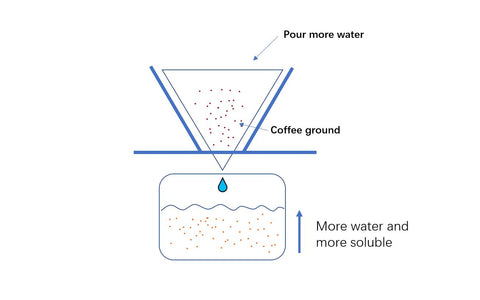Brewing basic concepts: Extraction Rate and Strength
A frequently asked question is “What should I do if the coffee tasted too strong”. There are mainly two kinds of answer, one is, rise the coffee to water ratio, which means use more water on the same amount of coffee ground; and the other is add water directly to the coffee. This question actually relates to two concepts: Extraction rate and Strength. Understanding these two concepts will lead you to your own answer of the starting question and future possible questions.
Extraction Rate
Remember in previous post What are we actually doing in coffee brewing? we mentioned coffee brewing is using water as solvent to dissolve solubles in coffee beans, then you know a cup of coffee is consist of soluble and water. Extraction rate is measuring “how many soluble you extract from the coffee bean in brewing”. It affects the flavours in your coffee, for example, under extracted coffee will tastes sour cause some "delicious materials were not be extracted; over extracted coffee will tastes bitter and burnt since the unpleasant material also been extracted. By the way, there is a formula to calculate extraction rate:
Extraction rate (%) = TDS (Total Dissolved Solids) x Brewed Coffee Mass (the liquid weight in you cup after brewing) / Dry Mass (The dry coffee ground after brewing)
Strength
This is referring to “the concentrate level of your coffee”. Usually measured by water and coffee ratio, like 1:15, 1:16...
By understanding these two concepts, you now know:
Adding water directly to coffee change the strength. With others remain unchanged, add more water means soluble takes less part in the whole cup of coffee, and this is the way to adjust the strength of coffee. If the coffee tasted too strong, you want to make it less punchy but don't want to change the flavours, then you can try adding more water directly to the cup.
Adding water to the coffee ground increased the extraction rate. With others remain unchanged, pour more water means more soluble will be dissolved from coffee bean, this is one of the ways to change the flavours of coffee, not strength. In a coffee bean, roughly 20% of soluble has good flavour and 10% are not, so rising the extraction rate will have risk to bring out the “bad flavours”, that’s what we call over extraction.
Below two pictures will help you get better understanding

(Strength)

(Extraction rate)
